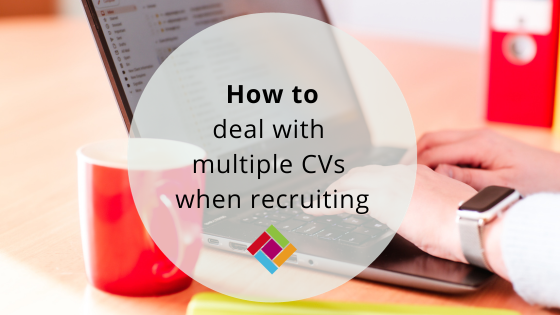
For a business owner with limited time and resources, recruiting for a role that attracts double, even triple the usual amount of applications can be impossible and overwhelming to manage. So, how can you deal with multiple CVs when recruiting?
Working with an agency
If you’re thinking of using a recruitment agency, here’s our guide on getting the most from the partnership. However, if you’re managing it in-house we’ve put together our advice on managing multiple CVs…
Be clear in your recruitment advertising
Stipulate exactly what you are looking for and what the role involves. Specify the level of experience required, and ask for examples of how candidates have demonstrated their skills in this particular area. By being clear at the job advert stage, you should discourage candidates who would not be relevant to the role.
This will also help manage expectations (and disappointment) from potential candidates if you’re able to justify why they weren’t shortlisted.
Use the job description in the next stage to help you filter down candidates. Don’t be afraid to close the post sooner if you’re becoming overwhelmed with applications. Read our guide to creating a job description and drafting the perfect recruitment advert.
Develop a scoring system
The easiest way to manage multiple CVs and applications is to develop a simple scoring system (for example, 1-3). Mark applications from 1 – 3 based on the criteria set out in your advert, looking at their experience, skills and any other relevant competencies.
Shortlist no more than 10 candidates
These are the candidates that you will progress onto telephone interviews for the next stage. Remember that not all 10 will potentially set up the calls; we have also experienced high volumes of applications and lots of no-shows for interviews. Behaviours are changing, and therefore not always as expected. We’ve put together a guide on candidates ghosting you here.
Manage candidate expectations
Even if you receive thousands of applications, it’s good practice to let candidates know if they haven’t heard from you by a certain date then their application is likely to have been unsuccessful, depending on how they apply you could set this up as an autoreply or put this on the job advert. For candidates who you’ve had a conversation with even just a phone call basic email to inform them, they have been unsuccessful is good etiquette; there’s nothing more frustrated from a job seeker perspective than a tumbleweed response when they have taken the time to apply for your role.
Conduct a telephone screen
The first stage of interviews should be conducted via a brief phone call with some basic questions. These questions should focus on some more practical aspects of the role including salary expectations, their ability to travel (if required) and help you gauge their phone manner. You will be able to quickly identify candidates who match your requirements. We recommend that you aim to whittle the pool down to no more than five candidates who will progress to the next stage. Remember to refer back to the job description at all times to ensure you’re shortlisting in line with your criteria and avoiding any bias.
Invite the second stage for a video interview
During the current climate, video interviews using tools like Zoom are the norm and most candidates are comfortable with this. Read our guide to remote recruitment tips for employers for tips on preparing for remote interviews and what to consider.
Issue job offers and contracts
Once you’ve found your candidates you can go ahead and issue job offers and contracts of employment. If your team works remotely then you will need to consider onboarding remotely (read our tips here). ACAS also has useful information and templates.
For more support with your recruitment, you can find out about how to work with our HR Consultants by downloading our sales and pricing brochure.